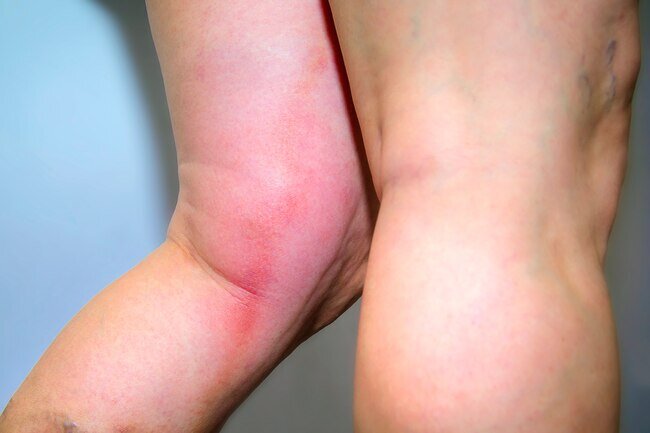6 Warning Signs of a Blood Clot in the Legs
Blood clots are a natural bodily process that is essential in preventing the loss of too much blood when one is injured or cut. However, a blood clot that occurs in a vein and creates a blockage can cause life-threatening complications. In the legs, blood clots can occur in superficial veins, called superficial thrombophlebitis or superficial vein thrombosis (SVT). They can also occur in deep veins and are called deep vein thrombosis (DVT).
How Dangerous Is a Blood Clot In the Legs?
A superficial clot in the legs can be very painful, and often occur in varicose veins. SVT can develop into a deep vein clot if not treated properly.
A deep vein blood clot (DVT) can be dangerous if it breaks off and travels through the veins to the lungs.
Every year up to 900,000 Americans are diagnosed with DVT and pulmonary embolism (a venous clot that affects the lungs). Approximately 100,000 people die of this type of blood clot annually, according to the Centers for Disease Control and Prevention (CDC)Trusted Source.
This is different from a clot in an artery. Arterial clots can prevent proper blood circulation and cause life-threatening emergencies such as a heart attack or stroke.
If you are worried that you might have a blood clot, contact your doctor immediately.
Warning Signs of a Blood Clot In Your Legs
Blood clots can have various symptoms including:
Swelling, which can develop in the exact spot where blood clots form or it causes swelling throughout the legs.
Pain - Leg pain is a common symptom of DVT. The pain can range from a dull ache to intense pain.
Tenderness
A warm sensation. You might feel the skin around your legs feel warmer than in other areas.
Changing color in your legs. Your legs might have redness or feel itchy.
Leg cramps
Depending on the size of the clots, you may not have noticeable symptoms. You might only have minor leg swelling without much pain. However, if left untreated, the clot can enlarge and become swollen and extremely painful.
What Are The Risk Factors?
You might have more chances of getting a blood clot in your legs if you are:
Over the age of 60
Sitting or standing for prolonged hours. Staying in the same position for long hours where muscles are not forced to contract. Muscle contraction is important for blood flow.
Experiencing a sedentary lifestyle.
Obese. Maintaining a healthy weight range is important. Excess weight can put additional pressure on your leg veins and pelvis.
Pregnant. With increased weight, increased blood volume, and hormonal changes, pregnancy is a major risk for blood clots. Women with an inherited clotting disorder are especially at risk. You still have a risk of blood clots from pregnancy up to 6 weeks after delivery.
Have a family history of blood clots.
Smoking
Taking certain birth control pills or hormone replacement therapy.
Had a recent hospital stay related to a major surgery.
Have cancer. Some forms of cancer increase substances in the blood and cause the formation of blood clots. Some cancer treatments can also increase the chances of blood clots.
When To See a Vein Doctor
According to the CDC Trusted Source, almost 50% of patients with DVT have no symptoms. Therefore, if you think you are at risk for blood clots, you should schedule a screening with one of our specialized vein doctors.
You should call local emergency services immediately if you are experiencing any of the following:
Sudden shortness of breath
Chest pressure
Difficulty breathing, seeing, or speaking
How To Prevent a Blood Clot In The Legs
1. Avoid Long Hours of Sitting or Standing
Sitting or standing for extended periods of time is a major cause of deep vein thrombosis. Move or flex your ankles and knees every 30 minutes to increase the blood flow.
2. Lead an Active Lifestyle
Having a sedentary lifestyle can negatively affect your leg circulation and lead to the development of blood clots in the legs.
If you are pregnant, it's especially important to keep moving. Pregnancy puts additional pressure on the leg veins due to increased blood volume, increased weight and hormonal changes. Try to go on regular walks or do exercise with low intensity such as swimming, jogging or yoga. Sleeping on your left side can also help promote blood circulation during pregnancy.
Read More: 5 popular exercises that are good for vein health
3. Drinking More Water
When your body becomes dehydrated, it holds fluid and causes swelling in the legs, feet, and ankles. If you travel or fly for long hours, remember to drink enough water and avoid drinks that dehydrate the body such as caffeine, alcohol or soda.
4. Wearing Compression Stockings
Compression stockings support leg circulation and help avoid blood blots in your legs. We advise having your compression stockings prescribed by a vein specialist.
Read More: All you need to know about compression stocking
5. Elevating Your Legs Before Sleeping
Try to elevate your legs before you sleep to help promote blood flow after a long day of sitting or standing. Elevating your legs above your hips is most effective.
6. Adjusting Your Diet
"You are what you eat." Managing your diet can make a positive impact on your leg health and prevent blood clots from forming.
Avoid eating salty and fatty food
Consume high-fiber food
Add fruit-bearing plants that are rich in flavonoids.
Read More:
Free Screening For Vein Disease
It’s best to consult a vein doctor or a vein specialist to receive an early diagnosis of your leg health. At Physicians Vein Clinics, our board-certified vein doctors have years of training and experience to treat deep vein thrombosis or prevent its formation. Book a free screening today or call us at (888) -782-8346 to have your questions answered.

